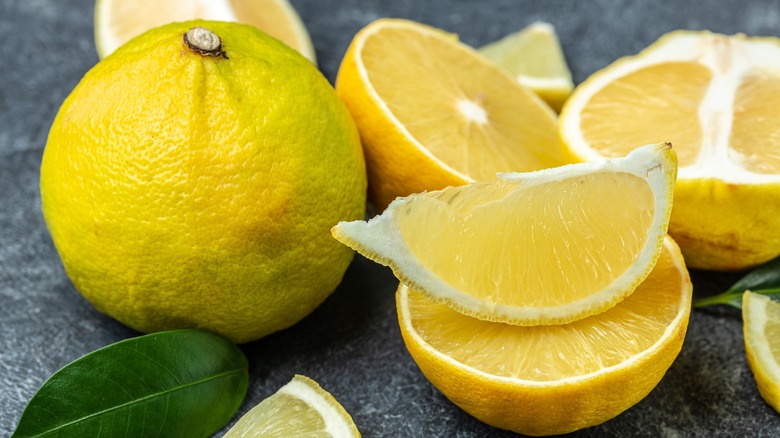The Unique Orange Variety You Should Never Eat Raw
Mandarins, tangerines, and clementines are just a few orange varieties prized for their juicy, sweet but tangy flesh. These citrus fruits can be consumed on their own as a snack or incorporated into delicious salads or desserts. But one lesser-known orange variety has often faded into the background, simply because it's just a bit different from the rest. Although you shouldn't consume it raw, it doesn't mean other ways to use it this orange can't be found.
Bergamot is the orange at hand, known for a bitter, unpleasant taste that can cause most to avoid it entirely. However, what bergamot fruit lacks in sweetness it makes up for in its valuable rind, laden with incredibly fragrant oils that can infuse whatever it touches with incredible citrus goodness. While it can't be snacked on like a sweet clementine, bergamot has a couple of unique uses in various foods that will surprise your palette. Keep a lookout for it the next time you're browsing citrus varieties in the produce section.
All about the beautifully bitter bergamot
While bergamot is a variety of orange, the citrus fruit can come in various shades ranging from a yellowish orange to a lime-like green. The color on the inside of the fruit can vary as well. The precious bergamot is mainly harvested for the essential oils in the rind. These oils are blended into delightfully fresh-smelling soaps or dreamy world fragrances, but tea lovers will know that bergamot oil is the main ingredient that gives Earl Grey tea its distinct flavor.
While citrus is known for its tangy brightness, don't mistake the citrus of bergamot as delicate. Bergamot is powerful enough to stand up to hearty black tea to make Earl Grey, bringing an unmistakable tang. But its scent and sourness are overwhelming to the point where it's quite difficult to incorporate it into everyday cooking, especially since it's just too bitter to eat raw. Earl Grey tea bags can become your next secret ingredient for a delicious pan sauce thanks to the magic of bergamot, but with some TLC, bergamot can become a delicious addition to your baked goods.
How to use bergamot in the kitchen
Avid bakers and novices alike can create highly flavorful baked treats with the small but mighty bergamot. As in Earl Grey tea, you'll want to harness the fragrant oils by focusing on the rind. Next time a recipe calls for lemon or orange zest, try substituting it for a bit of zest from the bergamot rind, like in a delicious citrus-based olive oil cake or a batch of cookies. Pepperidge Farm even created London Fog cookies trying to harness the flavors of Earl Grey tea.
But can the bergamot fruit's bitter flesh be put to good use at all? Certainly, just turn to marmalade. Marmalades are made by slowly cooking down fruit with sugar, a process that frees the bergamot of much of its bitter, sour taste while sweetening those powerful citrus oils. Or incorporate just a hint of bergamot into a cocktail that's meant to have bitter profiles, like a bergamot negroni. Whatever you choose to do with your potent bergamot, avoid eating it raw, and dig a little deeper to reap delicious rewards.


